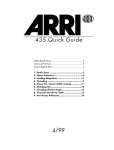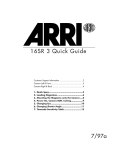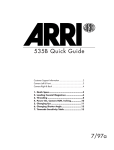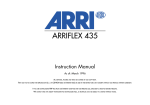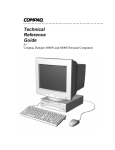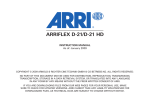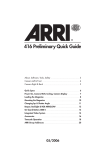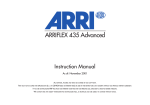Download ARRI ARRIFLEX 435 XTreme Specifications
Transcript
435 Quick Guide Customer Support/Safety Specifications ...........................2 Camera Left & Front........................................................3 Camera Right & Back .....................................................4 1. 2. 3. 4. 5. 6. 7. 8. Quick Specs.................................................5 Status Indicators..........................................6 Loading the ARRIMAG 120 (400’) ................7 Threading ...................................................9 Power On, Camera RUN, Inching...............11 Changing Fps ............................................12 Changing Shutter Angle.............................13 Timecode Sensitivity Table .........................15 9/97 Customer Support/Safety Specifications Customer Support If you have a question or problem, please contact one of our offices at the following addresses. In the case of inquiries or when ordering parts, please refer to the camera model and serial number. Arriflex Corporation, East Coast 617 Route 303, Blauvelt, NY 10913-1109 Voice phone: 914-353-1400 FAX: 914-425-1250 Email: [email protected] Website: http://www.arri.com Arriflex Corporation, West Coast 600 North Victory Blvd., Burbank, CA 91502-1639 Voice phone: 818-841-7070 FAX: 818-848-4028 435 and 435ES The ARRIFLEX 435 is available in two different models: the 435ES is equipped with an electronic shutter and a FEM (Functional Expansion Module). The standard 435 has a manually adjustable shutter and no FEM. Please note that the FEM is needed for the new 24 V accessories (including the CCU, RCU and ESU), for the LCC (Laptop Camera Controller) and for Timecode use. About This Quick Guide If you are viewing the Adobe Acrobat version of this Quick Guide, best viewing and printing results can be achieved through the use of the Acrobat Reader version 3.0 or later. The Acrobat Reader can be downloaded for free from the Adobe web site at http://www.adobe.com. Safety Specifications • The RS, ACC and CCU receptacles output the same voltage as is supplied to the BAT receptacle. If the BAT receptacle input voltage is above 32 V, the voltage output of the RS, ACC and CCU receptacles will be limited to 32 V/2 amp. Ensure that all accessories are suited to the supplied voltage. • When transporting the camera, make sure that the sliding door securing the field lens is all the way down. • When using the RCU, always reset the shutter angle to the desired value before disconnecting the RCU. • In order to ensure optimal performance, it is essential that you acquaint yourself with this Quick Guide and that you follow the operating instructions described herein. We strongly recommend that you also acquaint yourself with the full 435 instruction manual. • Assembly and initial operation should only be carried out after carefully reading the instructions and familiarizing yourself with the equipment and the assembly procedures. • Repairs should be carried out only by authorized service centers. Use only original ARRI accessories and replacement parts. • Never run the camera without a lens or a protective cap in the lens mount receptacle. • Never place your hand in the lens cavity or the inside of the camera while the camera is running! • Never open the movement or gate locking mechanism while the camera is running! • When manually adjusting the mirror shutter, turn the camera off and remove the power cable. Accidentally running the camera while manually adjusting the mirror shutter can cause great damage. • Clean optical surfaces only with an optical brush or a clean optical cloth. In cases of solid dirt, moisten an optical cloth with pure alcohol or a brand-name lens cleaner. • Do not use solvents when cleaning the film path. • Do not remove any screws which are secured with paint. Arriflex 435 Quick Guide, 9/97, Page 2 Camera Left & Front Eyecup 400 foot magazine Eyepiece focus adjustment Door lock safety button Eyepiece lock Magazine door lock Arriglow brightness adjustment Locking slider Camera door lock Run button Run indicator light NORM - PS/CCU switch MODE button PROG button Electronic inching/PHASE button SEL button LCD display SET button Image rotation knob Image rotation release Sliding door securing field lens Viewfinder Ground glass Viewfinder extension lock PL mount Friction adjustment Arriflex 435 Quick Guide, 9/97, Page 3 Camera Right & Back Grip system Tensioning plate Video assist port Mechanical footage counter Tensioning plate RS receptacle (remote RUN & 24 V dc) Functional expansion module (FEM) 24 V accessory overload light Compartment for 9 V timecode battery Contrast filter lever Viewfinder swivel release Tape hook Grip system 11 pin (12 V) accessory receptacle 12 V accessory overload light Functional expansion module (FEM) Magazine release latch Bubble level ACC receptacle (accessories) Magazine opening cover CCU receptacle (camera control unit) Two 3/8-16 mounting holes underneath camera Main power on/off switch Arriflex 435 Quick Guide, 9/97, Page 4 BAT receptacle (power input) 1. Quick Specs Fps range: ARRIMAG magazines: 1.000 to 150.00 fps, forward and reverse 35-3/2C magazines: 1.000 to 130.00 fps forward; reverse only with 35-3/2C 400’ (120m) magazines. 35-3 shoulder magazines cannot be used. Mirror shutter: 435ES: 435: 11.2° to 180.0°, electronically adjustable in 0.1° increments 11.2° to 180.0°, manually adjustable to: 11.2°, 22.5°, 30°, 45°, 60°, 75°, 90°, 105°, 120°, 135°, 144°, 172.8° and 180° Power: BAT: Up to 130 fps: 24 V dc in, above 130 fps: > 24 V dc in (Use 26 V (min. 7Ah) batteries to cover the whole fps range) Pin #1 is negative, pin #2 is positive Acceptable voltage range: 20.6 to 35 V dc RS: Pin #1 is GND, pin #2 is +24V dc out, pin #3 is /E-Run ACC Pin #4 is GND, pin #3 is +24 V dc out CCU: Pin #4 is GND, pin #3 is +24 V dc out 11-Pin: Pin #9 is GND, pin #11 is +12.6 V dc out Power output: All 24 V dc outputs total: max. 3 amp continuous, 5 amp peak All 12 V dc outputs total: max. 3 amp continuous, 5 amp peak Fuses: Movement: All 435 fuses are self-resetting thermal fuses. If blown, the respective overload light will illuminate. To reset fuse, disconnect all accessories and wait for one minute. Two three-pin pull-down film transport claws and two registration pins Flange focal distance: 51.98 - 51.97 mm Temperature range: -4° Fahrenheit to +122° Fahrenheit (-20°Celsius to +50°Celsius) Contrast Filter: Selectable ND 0.6 Electronic Accessories: IVS CCD-2FR RCU-1 LCC 1.3 CCU-1 LCS ICU-1 RS-4 ESU-1 Other Accessories: Integrated Video System Video Assist system Remote Control Unit Laptop Camera Controller Camera Control Unit Lens Control System Iris Control Unit (for speed/iris ramps) Remote On/Off Switch External Synchronization Unit 400’ magazine (ARRIMAG 120), 400’ Steadicam magazine (ARRIMAG 120S), 1000’ magazine (ARRIMAG 300E), a wide variety of zoom and prime lenses, viewfinder extenders, anamorphic viewfinder, heated eyecup, exchangeable ground glasses and Arriglow masks, various matte box systems, various follow focus systems, right side on/off button, right side handgrip, hand held shoulder supports, Steadicam support bracket, lens light, accessory connector splitter boxes, timecode exposure module, batteries, power supply, geared head, Varicon contrast control, obie light Arriflex 435 Quick Guide, 9/97, Page 5 2. Status Indicators Viewfinder indicators: Red LED ASY: END: BAT: Display indicators: Asynchronous operation; camera is not running at set fps rate Asynchronous operation; camera is not running at set fps rate Camera ran out of film Battery too low for the set fps rate ≤130 fps: less than 20.6 V; 130 - 150 fps: less than 24.1 V ■■ glows The display is in mode 1 bat glows Battery too low for the set fps rate ≤130 fps: less than 20.6 V; 130 - 150 fps: less than 24.1 V bat blinks Battery is too ”soft”, voltage will collapse on use asy glows Asynchronous operation; camera is not running at set fps rate asy blinks Movement and shutter are not synchronous end glows Camera ran out of film fps blinks Wrong magazine for currently set fps rate or, if connected, ESU is not getting a valid signal PROG glows Internal program is activated PROG blinks Internal program cannot be run: out-of-range fps or shutter values, wrong magazine for programmed fps values, or battery too low for programmed fps values R glows Camera is set to run in reverse TC glows Timecode exposure is enabled and timecode is set TC blinks Timecode exposure is enabled, but not recording properly OFF Lower line: SEL/SET button is pressed & locking slider is locked OFF Upper line in mode 7: electronic shutter of 435ES is off Shutter blinks See below Shutter blinks (435ES): Shutter blinks: Shutter blinks & red LED: Shutter blinks & red LED: The electronic shutter adjustment feature of the 435ES has been turned off. If shutter is locked, it should be unlocked. If shutter is unlocked, the electronic adjustment feature is defective. Turn electronic adjustment off and set the shutter manually to continue filming. Display warnings: The LCD Display will indicate any situations that will prevent running the camera by changing one or more of its digits into underlines. 1000’ ARRIMAG not ready ft fps No reverse operation with 35-3/2C 1000’ magazine! 00000 _0000 Movement block not locked Arriflex 435 Quick Guide, 9/97, Page 6 Secondary shutter/movement monitor triggered or defective. 3. Loading the ARRIMAG 120 (400’) In addition to the new ARRIMAG magazines, all 35-3 and 35-2C magazines - with the exception of the shoulder magazines - can be used on the 435. The ARRIMAGs run up to 150 fps, the 35-3/2C magazines up to 130 fps. The ”fps” symbol will flash if a magazine is attached that cannot be used for the set fps rate or camera running direction. All magazines are loaded with the same loop length as on the 35-3. Timecode can only be recorded with the new ARRIMAGs. Always make sure that a loop protector is on the magazine when it is not on the camera. Always make sure that the magazine opening cover is on the camera when no magazine is attached. Note: Reverse operation with 35-3/2C 200’ (60 m) magazines can damage the camera! Step 1: The Feed Side Load unexposed film only in absolute dark - such as in a dark room or changing bag. Short ends load easier if you cut the film head through the center of the perforations. Ensure that an empty plastic core is on the take-up shaft before starting the loading procedure. Note: Make sure that the spring loaded key of the take-up shaft engages into the keyway of the plastic film core. Failure to do so can lead to film jams, especially during high speed takes! • Remove the loop protector. • Push the safety catch on the magazine door lock towards the magazine throat and flip the lock up. Turn the lock counter clockwise until it stops and open the door. • Swing both roller arms away from the feed and take-up shafts until they lock in place (see graphic). • Remove the film from the film container. • Remove the tape from the film end. Make sure that the tape is completely removed. • Place the film roll to the left of the magazine (see graphic). • Push the film into the left slit on the magazine throat from the inside (see graphic). Once the film engages the sprocket roller inside the magazine throat, turn the drive gear counter clockwise until the film emerges on the outside of the magazine throat. Magazine door Feed shaft Roller arms Take-up shaft Magazine throat Drive gear Arriflex 435 Quick Guide, 9/97, Page 7 • Flip up the hinged clip on the feed shaft. • Now place the film on the feed shaft and push the film core down as far as it will go. Do not press on the film itself, as it could become conical. • Hold the plastic core and turn the feed shaft until the spring loaded key on the feed shaft engages into the keyway of the plastic core. Failure to do so can lead to film jams, especially during high speed takes! • Flip down the hinged clip to lock the film core on the feed shaft. • Turn the drive gear counter clockwise until the film reaches the loop length marking. Drive gear Hinged clip on feed shaft Loop length marking Step 2: The Take-up Side • Hold the drive gear to keep the loop length stable. Push the film gently into the right slit on the magazine throat from the outside until it engages with the sprocket roller inside the magazine throat. • Turn the drive gear counter clockwise to transport the film into the magazine. • Fold over the first 1/8th” (5 mm) of the film head. Place the head in the plastic film core slot. Note: Ensure that the film head does not stick out below the plastic film core, as this could lead to jams! • With a fingernail, smooth out the film where it emerges from the plastic film core. • Turn the drive gear counter clockwise until some film is wound on the take-up core. • Ensure that both hinged clips are locked down, then close the magazine door. The roller arms automatically unlock. Turn the magazine door lock clockwise and flip it back into the recess. • Pull up on the magazine door to double check that it is properly locked. Film loop Drive gear Arriflex 435 Quick Guide, 9/97, Page 8 Plastic film core Magazine throat 4. Threading Attaching the Magazine to the Camera • Remove the magazine opening cover and open the camera door. Make sure that the movement is in the forward (closed) position. Upper dovetail area Magazine release latch Magazine opening cover Lower dovetail area • Hold the magazine next to the camera so you can pull the film loop into the camera as far as it will go (see left graphic below). Position the back of the magazine throat on the lower dovetail of the camera. • Push the magazine all the way onto the camera to lock it in place. Especially in the upper dovetail area make sure that the film will not get caught between the magazine and the camera opening! Note: If the magazine drive gear does not engage the camera drive gear easily, you can slightly turn the inching knob of the movement to help. • Pull up on the magazine to double check that it is properly seated and locked on the camera. Threading the Film • Pull the film loop out of the camera (see left graphic below) and push it into the upper loop area. • Slide the film in between the movement and the film gate as far as it will go (see right graphic below). Upper loop area Movement Film gate Inching knob Movement in forward (closed) position Arriflex 435 Quick Guide, 9/97, Page 9 • Ensure that the white line on the inching knob aligns with the LOADING POSITION line on the movement. • Turn the movement locking lever to the OPEN position to swing the movement away from the film gate. Slide the film into its proper place between the film gate and the movement. • Place the film onto the positioning pin so that the upper film loop is in the center of the film loop marking. Film loop marking Positioning pin Inching knob Movement locking lever Film gate Pitch Adjustment knob • Make sure that the film is properly positioned along the whole film gate (film edge parallel to gate edge), and close the movement by turning the movement locking lever counter clockwise. • To check for proper film transport, turn the inching knob clockwise. Alternatively, you can push the PHASE button to electronically inch the camera. Note: The LCD display will show the open mirror shutter angle and the battery voltage when the PHASE button is pushed. This allows you to check these values each time you reload! Note: The movement and the mirror shutter of the 435 are linked electronically, and will only move together when the camera is running or when it is inched with the PHASE button. When the camera is manually inched, the mirror shutter will not rotate. • Run the camera briefly at 24 fps to check for proper threading. With a little practice you will be able to hear if there is any problem by the sound of film running through the camera at 24 fps. • If you have the same film stock loaded that you will be using for the shoot, turn the pitch adjustment knob while the camera is running at 24 fps until you hear the least amount of movement noise. This will insure smoother running, especially during high speed takes. • Close and lock the camera door. Note: Especially before high speed takes it is a good idea to ensure that the film in the magazine is under some tension. To do this, press the PHASE button for 5 seconds or briefly run the camera at 24 fps or press in both tension plates on the magazine and wind the film up. • If you are using Timecode, now is a good time to set the Timecode Sensitivity (TCS) number: - Look up the proper TCS number from the back of this Quick Guide. - Press the mode button five times to change to mode 6 on the LCD display. You should see an ”S” and a number in the bottom line of the display. - Press the SEL button until the digit to the right of the ”S” blinks. This is the TCS number. - Press the SET button to change the TCS number. - Press the SEL button to confirm your entry. Arriflex 435 Quick Guide, 9/97, Page 10 5. Power On, Camera RUN, Inching Turning Camera Power On The main power switch for the ARRIFLEX 435 is located on the back of the camera, underneath the magazine mounting port. When a battery is attached to the camera and the main power switch is turned on, you should see characters appear on the LCD display on the camera left side. The two accessory overload lights will also illuminate briefly to show that they are operational. Camera RUN The RUN button is located on the left side of the camera. To run the camera, depress the RUN button briefly. To stop the camera depress the RUN button again briefly. The RUN indicator light will glow red while the camera is coming up to speed, and switch to green once the set frame rate is reached. The RUN indicator light will steadily glow green when the camera is running at the set frame rate. When the RUN button is pushed again to stop camera run, the light will briefly glow red, then green, and then turn off. Note: If the RUN indicator light glows red while the camera is in Standby, the camera is not ready and pushing the RUN button will have no effect. Inching The ARRIFLEX 435 can be inched manually with the inching knob or electronically with the PHASE button. The PHASE button, if pushed very briefly, will also rotate the mirror shutter 180°. This allows for a fast gate check. To move the mirror shutter back into the viewing position, push the PHASE button again briefly. • To manually inch the camera, open the camera door and turn the inching knob clockwise. Note: Any film in the movement area will be exposed to light when inching manually! Note: The movement and the mirror shutter of the 435 are linked electronically, and will only move together when the camera is running or when it is inched with the PHASE button. When the camera is manually inched, the mirror shutter will not rotate. • To electronically inch the camera, press the PHASE button while the camera is in Standby. Main power switch NORM - PS/CCU switch LCD display RUN button RUN indicator light Arriflex 435 Quick Guide, 9/97, Page 11 Electronic inching/PHASE button 6. Changing Fps With the NORM - PS/CCU switch on the camera's left side in the NORM position, the standard speeds of 23.976, 24, 25, 29.97 and 30 fps, forward or reverse, can be run. In the PS/CCU position, any speed from 1.000 to 150.00 fps, forward or reverse, can be run. All speeds set on the camera are crystal speeds. The ARRIMAGs run up to 150 fps, the 35-3/2C magazines run up to 130 fps. The ”fps” symbol will flash if a magazine is attached that cannot be used for the set fps rate or camera running direction. Note: The NORM - PS/CCU switch only affects the fps setting, not the mirror shutter setting. Setting a Standard Speed • Ensure that the locking slider is in the unlocked (right) position. • Make sure the LCD display is in mode 1 (black bar is visible). • Push the SEL button to cycle through the available standard speeds (23.976, 24, 25, 29.97 and 30 fps). Each speed will flash for approximately 3 seconds. • While a speed is flashing, push the SET button to set it. Note: Set the NORM - PS/CCU switch to NORM to run the camera at the set standard speed. Setting a Programmable Speed • Ensure that the locking slider is in the unlocked (right) position. • Push the MODE button once to change from mode 1 to mode 2 ("PS" - programmable speed). • Press the SEL button to select one digit after the other. A selected digit will blink. Press the SET button to increment the value of a blinking digit by one. Repeat this procedure for all digits that need to be changed. Speeds below 100 fps are shown in the display with three digits past the decimal point. Speeds of 100 fps and above are shown with two digits past the decimal point. Note: Set the NORM - PS/CCU switch to PS/CCU to run the camera at the set programmable speed. Setting the Camera to run in Reverse • Ensure that the locking slider is in the unlocked (right) position. • Push the MODE button once to change from mode 1 to mode 2. • Press the SEL button once. "cd" (camera direction) will blink. • Push the SET button for three seconds. When the camera is set to run in reverse, the letter ”R” appears in the display. Note: The ”R” symbol is the only indication that the camera will run in reverse. Pay close attention! Note: Camera direction will be set to reverse for the standard speeds (NORM) and for the programmable speeds (PS). LCD display in mode 1. Current frame rate set at 24.000 fps. LCD display in mode 2. Current frame rate set at 150.00 fps. LCD display in mode 2. Current frame rate set at reverse 150.00 fps. Arriflex 435 Quick Guide, 9/97, Page 12 7. Changing Shutter Angle Checking the Mirror Shutter Angle (435 & 435ES) • Push the PHASE button for about 5 seconds while the camera is in standby. • The top line of the LCD display will show the open angle of the mirror shutter. The bottom line will show the battery voltage. Note: The 435ES shutter angle is also visible in mode 7. Note: To always view the 435ES shutter angle in mode 1: - Make sure the display is in mode 1 (black bar visible). - Push the SEL button until the upper line blinks. - Push the SET button to switch the upper line between the footage counter and the shutter angle. LCD display with PHASE button pressed. Open mirror shutter angle (22.5°) and battery voltage (24.2 V) are visible. Electronically Changing the Mirror Shutter Angle (435ES) The open mirror shutter angle of the 435ES can be set in 0.1° increments by the LCC, RCU or CCU. The following shutter angles can be set directly on the camera: 11.2°, 22.5°, 30°, 45°, 60°, 75°, 90°, 105°, 120°, 135°, 144°, 172.8° and 180°. Note: Before electronically adjusting the shutter, make sure that the shutter is unlocked. Check with a 2 mm hex driver that the shutter lock (labeled CATCH) is in the LOOSE position (all the way counter-clock wise). The locking tab should not be visible (see graphic). Attempting to electronically adjust the shutter while it is locked can damage the camera! • Change the LCD display to mode 7 by pushing the MODE button six times. The display should show the shutter symbol and the current shutter angle in the top line, and the fps rate in the bottom line. If the display shows ”OFF”, the electronic adjustment of the shutter is deactivated. • Press the SEL button repeatedly until the desired shutter angle blinks in the display. • Press the SET button to confirm the blinking shutter angle. Note: If a blinking shutter angle is not confirmed within 3 seconds, the shutter angle will revert to the previously set value. Locking tab not visible Shutter lock Locking tab visible Shutter lock Arriflex 435 Quick Guide, 9/97, Page 13 Turning Electronic Shutter Adjustment Off (435ES) It is possible to turn the 435ES electronic shutter adjustment off. Once the electronic shutter is off, the shutter can be adjusted manually. As long as the electronic shutter is turned off, the shutter symbol will blink in the LCD display as a reminder. • Change the LCD display to mode 7 until you see the shutter symbol and the current shutter angle. • Press the SEL button until the word ”OFF” blinks in the display. • Press the SET button to confirm. • Set the desired shutter angle manually (see below). Manually Adjusting the Mirror Shutter Angle (435 & 435ES) Note: Before manually adjusting the shutter of the 435ES, make sure that the electronic adjustment is off. Manually adjusting the 435ES shutter while the electronic adjustment is on can damage the camera! Note: Before manually adjusting the shutter, turn the main power switch off. Accidentally running the camera while manually adjusting the shutter can cause great damage! • Remove the lens or lens mount cavity cap. • Use a finger on the black center area of the shutter assembly to carefully rotate the shutter until the adjustment screw and the shutter lock are visible (see graphic). Do not touch the mirror shutter itself! • With a 2 mm hex driver turn the shutter lock (labeled CATCH) counter clockwise towards the LOOSE position until it stops. • Now use the 2 mm hex driver to turn the adjustment screw (labeled SHUTTER BLADE). You will see the shutter blade turn out from under the mirror. Position the blade at one of the labeled default positions. • Turn the shutter lock with the 2 mm hex driver back towards the LOCK position (clockwise), until the silver locking tab snaps into a cut out. If it does not engage into a cut out, reposition the shutter blade slightly by turning the adjustment screw until the locking tab engages. Shutter lock Adjustment screw Black center area of shutter assembly Arriflex 435 Quick Guide, 9/97, Page 14 8. Timecode Sensitivity Table Notes This table is in effect as of September1997. Timecode recording is possible at the standard speeds of 23.976, 24, 25, 29.97 and 30 fps. † = Emulsion no longer available from manufacturer. 35 mm Kodak Film Stocks 35 mm Fuji Film Stocks Emulsion Type TCS Emulsion Type TCS 5222 † 5224 5231 † 5239 † 5240 5245 5246 5248 5274 5277 5279 † 5287 5293 † 5294 † 5295 † 5296 5297 5298 5620 B/W Negative B/W Reversal B/W Negative Color Reversal Color Reversal Color Negative Color Negative Color Negative Color Negative Color Negative Color Negative Color Negative Color Negative Color Negative Color Negative Color Negative Color Negative Color Negative Color Negative 8 8 8 6 5 7 6 7 6 5 5 6 6 5 4 5 5 5 5 † 8510 † 8514 † 8520 8521 † 8530 8531 † 8550 8551 † 8560 8561 † 8570 † 8571 Color Negative Color Negative Color Negative Color Negative Color Negative Color Negative Color Negative Color Negative Color Negative Color Negative Color Negative Color Negative 7 5 5 7 6 7 4 6 6 5 6 5 Arriflex 435 Quick Guide, 9/97, Page 15















